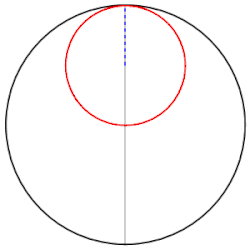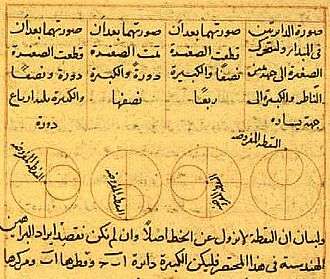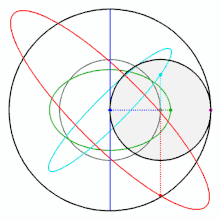Tusi couple
The Tusi couple is a mathematical device in which a small circle rotates inside a larger circle twice the diameter of the smaller circle. Rotations of the circles cause a point on the circumference of the smaller circle to oscillate back and forth in linear motion along a diameter of the larger circle. The Tusi couple is a 2-cusped hypocycloid.

The couple was first proposed by the 13th-century Persian astronomer and mathematician Nasir al-Din al-Tusi in his 1247 Tahrir al-Majisti (Commentary on the Almagest) as a solution for the latitudinal motion of the inferior planets,[1] and later used extensively as a substitute for the equant introduced over a thousand years earlier in Ptolemy's Almagest.[2][3]
Original description

Some modern commentators also call the Tusi couple a "rolling device" and describe it as a small circle rolling inside a large fixed circle. However, Tusi himself described it differently:
- If two coplanar circles, the diameter of one of which is equal to half the diameter of the other, are taken to be internally tangent at a point, and if a point is taken on the smaller circle—and let it be at the point of tangency—and if the two circles move with simple motions in opposite direction in such a way that the motion of the smaller [circle] is twice that of the larger so the smaller completes two rotations for each rotation of the larger, then that point will be seen to move on the diameter of the larger circle that initially passes through the point of tangency, oscillating between the endpoints.[5]
Relation to al-Tusi's astronomical theories
Nasir al-Din al-Tusi, born in the town of Tus, Iran in 1201, is acknowledged throughout the Islamic world as one of the 'Great Wisdoms'. Tusi was the first astronomer to attempt a solution which would provide for latitudinal motion without introducing a longitudinal component. To do so, he proposed in a work called Tahrir al-Majisti, which was completed in 1247, that the oscillatory motion be produced by the combined uniform circular motions of two identical circles, one riding on the circumference of the other. At that point, Tusi simply states that if one of these circles were to move at a uniform speed equal to twice the speed of the other, and in a direction to it, then any point on the circumference of the first circle would oscillate in a straight line along one of the diameters of the second circle[6]
Other sources
The term "Tusi couple" is a modern one, coined by Edward Stewart Kennedy in 1966.[7] It is one of several late Islamic astronomical devices bearing a striking similarity to models in Nicolaus Copernicus's De revolutionibus, including his Mercury model and his theory of trepidation. Historians suspect that Copernicus or another European author had access to an Arabic astronomical text, but an exact chain of transmission has not yet been identified,[8] although the 16th century scientist and traveler Guillaume Postel has been suggested.[9][10]
Since the Tusi-couple was used by Copernicus in his reformulation of mathematical astronomy, there is a growing consensus that he became aware of this idea in some way. It has been suggested[11][12] that the idea of the Tusi couple may have arrived in Europe leaving few manuscript traces, since it could have occurred without the translation of any Arabic text into Latin. One possible route of transmission may have been through Byzantine science, which translated some of al-Tusi's works from Arabic into Byzantine Greek. Several Byzantine Greek manuscripts containing the Tusi-couple are still extant in Italy.[13]
There are other sources for this mathematical model for converting circular motions to reciprocating linear motion. It is found in Proclus's Commentary on the First Book of Euclid[14] and the concept was known in Paris by the middle of the 14th Century. In his questiones on the Sphere (written before 1362), Nicole Oresme described how to combine circular motions to produce a reciprocating linear motion of a planet along the radius of its epicycle. Oresme's description is unclear and it is not certain whether this represents an independent invention or an attempt to come to grips with a poorly understood Arabic text.[15]
Later examples
Although the Tusi couple was developed within an astronomical context, later mathematicians and engineers developed similar versions of what came to be called hypocycloid straight-line mechanisms. The mathematician Gerolamo Cardano designed a system known as Cardan's movement (also known as a Cardan gear).[16] Nineteenth-century engineers James White,[17] Matthew Murray,[18] as well as later designers, developed practical applications of the hypocycloid straight-line mechanism.
Hypotrochoid

A property of the Tusi couple is that points on the inner circle that are not on the circumference trace ellipses. These ellipses, and the straight line traced by the classic Tusi couple, are special cases of hypotrochoids.[19]
See also
Notes
| Wikimedia Commons has media related to Tusi-couple. |
- George Saliba (1995), 'A History of Arabic Astronomy: Planetary Theories During the Golden Age of Islam', pp.152-155
- "Late Medieval Planetary Theory", E. S. Kennedy, Isis 57, #3 (Autumn 1966), 365-378, JSTOR 228366.
- Craig G. Fraser, 'The cosmos: a historical perspective', Greenwood Publishing Group, 2006 p.39
- Vatican Library, Vat. ar. 319 fol. 28 verso math19 NS.15 Archived 2014-12-24 at the Wayback Machine, fourteenth-century copy of a manuscript from Tusi
- Translated in F. J. Ragep, Memoir on Astronomy II.11 [2], pp. 194, 196.
- Saliba, George; Kennedy, E. S. Arabic Sciences and Philosophy (1st ed.). pp. 285–291.
- E. S. Kennedy, "Late Medieval Planetary Theory," p. 370.
- E. S. Kennedy, "Late Medieval Planetary Theory," p. 377.
- Saliba, George (1996), "Writing the History of Arabic Astronomy: Problems and Differing Perspectives", Journal of the American Oriental Society, 116 (4): 709–18, doi:10.2307/605441, JSTOR 605441, pp. 716-17.
- Whose Science is Arabic Science in Renaissance Europe? by George Saliba, Columbia University
- Claudia Kren, "The Rolling Device," p. 497.
- George Saliba, "Whose Science is Arabic Science in Renaissance Europe?"
- George Saliba (April 27, 2006). "Islamic Science and the Making of Renaissance Europe". Retrieved 2008-03-01.
- Veselovsky, I. N. (1973). "Copernicus and Nasir al-Din al-Tusi". Journal for the History of Astronomy. 4: 128–30. Bibcode:1973JHA.....4..128V. doi:10.1177/002182867300400205.
- Claudia Kren, "The Rolling Device," pp. 490-2.
- Veselovsky, I. N. (1973). "Copernicus and Nasir al-Din al-Tusi". Journal for the History of Astronomy. 4: 128. Bibcode:1973JHA.....4..128V. doi:10.1177/002182867300400205.
- "Appleton's dictionary of machines, mechanics, engine work, and engineering". 1857.
- "Polly Model Engineering: Stationary Engine Kits - Anthony Mount Models".
- Brande, W.T. (1875), A Dictionary of Science, Literature, & Art, Longmans, Green, and Company, p. 181, retrieved 2017-04-10
References
- Di Bono, Mario (1995). "Copernicus, Amico, Fracastoro and Tusi's Device: Observations on the Use and Transmission of a Model". Journal for the History of Astronomy. 26: 133–154. Bibcode:1995JHA....26..133D. doi:10.1177/002182869502600203.
- Kennedy, E. S. (1966). "Late Medieval Planetary Theory". Isis. 57 (3): 365–378. doi:10.1086/350144.
- Kren, Claudia (1971). "The Rolling Device of Naṣir al-Dīn al-Ṭūsī in the De spera of Nicole Oresme". Isis. 62 (4): 490–498. doi:10.1086/350791.
- Ragep, F. J. "The Two Versions of the Tusi Couple," in From Deferent to Equant: A Volume of Studies in the History of Science in Ancient and Medieval Near East in Honor of E. S. Kennedy, ed. David King and George Saliba, Annals of the New York Academy of Sciences, 500. New York Academy of Sciences, 1987. ISBN 0-89766-396-9 (pbk.)
- Ragep, F. J. Nasir al-Din al-Tusi's "Memoir on Astronomy," Sources in the History of Mathematics and Physical Sciences,12. 2 vols. Berlin/New York: Springer, 1993. ISBN 3-540-94051-0 / ISBN 0-387-94051-0.
External links
- Dennis W. Duke, Ancient Planetary Model Animations includes two links of interest:
- George Saliba, "Whose Science is Arabic Science in Renaissance Europe?" Discusses the model of Nasir al-Din al-Tusi and the interactions of Arabic, Greek, and Latin astronomers.